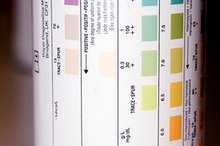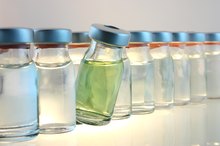Real Life Uses of Titration
Titration is a process or method to determine the concentration of a substance in a solution, in which a known reagent is added to a solution of unknown concentration. Carefully measured amounts of the reagent are added until a change in color or electrical measurement occurs. Once a reaction of definite and known proportion takes place, it can be measured and used to calculate the unknown concentration.
Medical Uses
Pharmacists use titration to achieve a desired mix of compound drugs. Doctors will often employ titration to determine the correct proportion of different medicines in an intravenous drip. Titration is also used to monitor blood glucose levels in patients with diabetes, as well as in pregnancy tests and other applications of urinalysis.
Food Industry Uses
Color of Urine Strips for Ketosis
Learn More
Titration can be used to define oils, fats and similar substances. Specific titration procedures exist to test free fatty acid content, unsaturated fatty acids and trace amounts of water 2. Titration is also used to determine the estimated chain length of fatty acids in a fat. Other uses of titration in the food industry include tests for the amount of salt or sugar, and the concentration of vitamin C or E, in a product. Titration is also used in wine and cheese production to test the product's readiness for consumption.
- Titration can be used to define oils, fats and similar substances.
- Titration is also used to determine the estimated chain length of fatty acids in a fat.
Science and Education
Titration can be employed in biology labs, where it is used to determine the proper concentration of chemicals to anesthetize test animals. Anesthetic agents are mixed and tested until the desired compound appropriate to a given animal is achieved.
In high school chemistry classes, titration is often used as a test of students' practical aptitude. It is a standard procedure, requiring adherence to instructions and proper handling of substances, and its easily measurable results can quickly indicate whether or not the procedure was followed according to instructions.
- Titration can be employed in biology labs, where it is used to determine the proper concentration of chemicals to anesthetize test animals.
Biodiesel Production
What Is MSG Made Of?
Learn More
Titration is used in the production of biodiesel to determine the acidity of waste vegetable oil, one of the primary ingredients in biodiesel production. By testing a small sample with pH paper, the pH of the entire batch can be measured and the amount of base needed to achieve the desired pH can be determined.
Aquarium Water Testing
Titration is used to test the underwater environment in fresh water and marine aquariums. Properties such as water pH and concentration of ammonia, nitrates and nitrites are measured and then corrected to ensure the survival of marine life being kept in the aquarium.
Related Articles
References
Writer Bio
Rob Callahan lives in Minneapolis, where he covers style, culture and the arts for Vita.MN and "l'étoile Magazine." His work has earned awards in the fields of journalism, social media and the arts. Callahan graduated from Saint Cloud State University in 2001 with a Bachelor's degree in philosophy.









